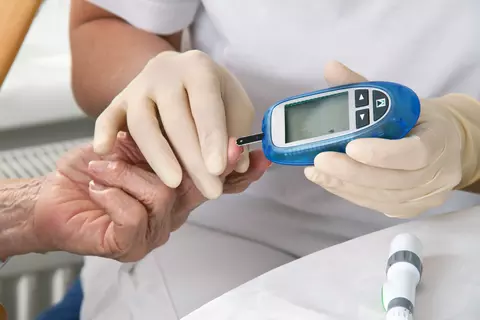Optimal glycemic control in patients with diabetes is associated with a reduced risk of colorectal adenoma and cancer
Mao X et al, Gut. 2024;73(8):1313–20
In this Asian cohort study of patients with diabetes, optimal glycemic control (HbA1c < 7%) was associated with a 13–27% reduced risk of any, non-advanced and advanced colonic adenoma. Moreover, risk of left-sided colorectal carcinoma was reduced by 28%.
Objective: Whether varying degrees of glycaemic control impact colonic neoplasm risk in patients with diabetes mellitus (DM) remains uncertain.

Design: Patients with newly diagnosed DM were retrieved from 2005 to 2013. Optimal glycaemic control at baseline was defined as mean haemoglobin A1c (HbA1c) < 7%. Outcomes of interest included colorectal cancer (CRC) and colonic adenoma development. The authors used propensity score matching with competing risk models to estimate subdistribution hazard ratios (SHRs). They further analysed the combined effect of baseline and postbaseline glycaemic control based on time-weighted mean HbA1c during follow-up.
Results: Of 88,468 propensity score-matched patients with DM (mean [standard deviation] age, 61.5 [± 11.7] years; male, 47,127 [53.3%]), 1229 (1.4%) patients developed CRC during a median follow-up of 7.2 (interquartile range, 5.5–9.4) years. Optimal glycaemic control was associated with lower CRC risk (SHR = 0.72; 95% confidence interval [CI]: 0.65–0.81). The beneficial effect was limited to left-sided colon (SHR = 0.71; 95% CI: 0.59–0.85) and rectum (SHR = 0.71; 95% CI: 0.57–0.89), but not right-sided colon (SHR = 0.86; 95% CI: 0.67–1.10). Setting suboptimal glycaemic control at baseline/postbaseline as a reference, a decreased CRC risk was found in optimal control at postbaseline (SHR = 0.79), baseline (SHR = 0.71) and both time periods (SHR = 0.61). Similar associations were demonstrated using glycaemic control as a time-varying covariate (HR = 0.75). A stepwise greater risk of CRC was found (ptrend < 0.001) with increasing HbA1c (SHRs = 1.34, 1.30, 1.44, 1.58 for HbA1c 7.0% to < 7.5%, 7.5% to < 8.0%, 8.0% to < 8.5% and ≥ 8.5%, respectively). Optimal glycaemic control was associated with a lower risk of any, non-advanced and advanced colonic adenoma (SHRs = 0.73–0.87).
Conclusion: Glycaemic control in patients with diabetes mellitus was independently associated with the risk of colonic adenoma and colorectal cancer development with a biological gradient.